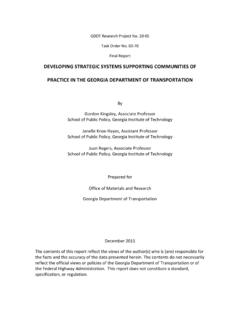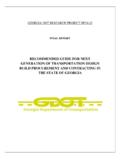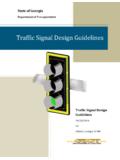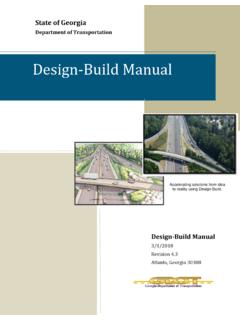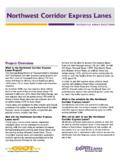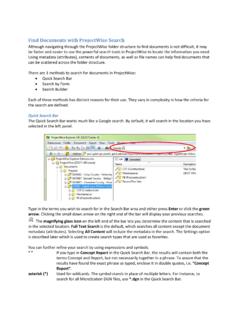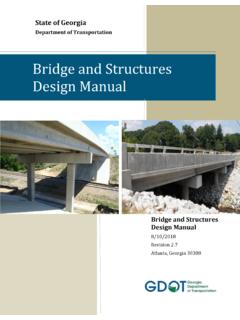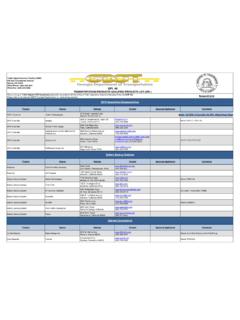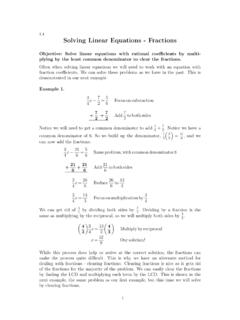Transcription of Basic Highway Plan Reading - Georgia
1 Skills Development Series Basic Highway plan Reading Basic Highway plan Reading Basic Highway plan Reading Reproduction of any or all portions of this Manual is prohibited without the written consent of the Georgia Department of Transportation. developed in conjunction with Revised October 1, 2020 List of Figures .. vi Forward .. ix A Note on Safety .. x Nuts and Bolts of the Course .. xi Chapter 1 Beginning to Read Plans .. 1 General Information .. 1 Requirements and Specifications .. 1 What Part of The Contract Applies? .. 1 In Case of A Discrepancy, Certain Parts of The Contract Govern Over Others .. 1 Sheet Order .. 1 Errors or Omissions .. 2 Cover Sheet .. 2 Description .. 4 Project Location Sketch .. 5 Layout View .. 5 Sheet Identification .. 6 Plans Revised and Plans Completed .. 8 Scale .. 8 Project Length .. 10 Cover Sheet Questions .. 10 Design Data.
2 10 Chapter 2 Index and Revision Summary Sheet .. 11 Index .. 11 Revision Summary Sheet .. 11 Chapter 3 Typical Sections .. 13 Introduction to Typical Sections .. 13 Horizontal Distance .. 14 Chapter 4 Summary & Detailed Estimate Quantities .. 15 Summary of Quantities .. 15 (Continued on page ii) Table of Contents i Table of Contents 2 Table of Contents Drainage Summary ..15 Detailed Estimate ..16 Chapter 5 Views ..19 Introduction to Views ..19 Longitudinal Cross section ..19 Cross section ..20 Profile View ..20 Chapter 6 Stationing, Symbols, And Abbreviations ..23 Stationing ..23 Half Stations ..24 Station Equations (Equalities) ..26 Determining of The Project Length ..27 Symbols and Abbreviations Introduction to Symbols ..28 Introduction to plan Abbreviations ..28 Conventional and Right of Way (ROW) Symbols ..29 Utility Symbols Water Mains ..30 Gas Mains and Petroleum Product Pipe Lines ..31 Sanitary Sewer and Steam Lines.
3 32 Electrical Power ..33 Telephone and Telegraph ..34 Television/ and Microwave Cable ..35 Utility Abbreviations and Railroad ..36 Chapter 7 plan and Profile Sheets ..37 plan View ..37 Horizontal Alignment ..39 Superelevation ..41 Bearings ..42 (Continued on page iii) Table of Contents iii Profile View (Vertical Alignment) ..45 Elevations ..46 Grade ..47 Vertical Curves and Grade Point ..48 Paving Limits ..49 Construction Limits ..50 Fencing ..50 Guard Right of Way Markers ..50 Chapter 8 Drainage ..53 Pipe Culverts ..53 Box Culverts ..54 plan View ..57 Wing Walls ..58 Bridges ..60 Bents ..62 Utility Accommodations ..64 Chapter 9 Utilities ..67 Chapter 10 Signing, Pavement Markings, Signals, Highway Lighting, Landscaping..69 Traffic Signals ..69 Lighting..69 Landscaping ..69 Chapter 11 Maintenance of Traffic, Sequence of Operations, and Chapter 12 Erosion, Sedimentation, And Pollution Control Plans (ESPCP).
4 73 Introduction to Erosion Control ..73 When Are ESPCP Necessary? ..73 What Is Included in the ESPCP? ..74 (Continued on page iv) 4 Table of Contents Contractor Responsibilities ..74 Examples from the Plans ..75 Chapter 13 Cross Sections Introduction to Cross Sections ..77 Earthwork ..77 Grade ..80 Slopes ..80 Slope Stakes ..81 Chapter 14 Standards & Details Introduction to Standards & 85 Intersection Details ..85 Chapter 15 Right of Way Introduction ..87 Right of Way Terms and Definitions ..88 Right of Way plan Sheets ..91 Questions for Appendices ..95 Appendix A: Definitions ..97 Appendix B: Abbreviations ..107 Answers to Chapter Questions Chapter 1 ..117 Chapter 2 ..117 Chapter 3 ..117 Chapter 4 ..117 Chapter 5 ..117 Chapter 6 ..118 Chapter 7 ..118 Chapter 8 ..120 Chapter 9 ..120 Chapter 10 ..121 Chapter 11 ..121 Chapter 12 ..121 Chapter 13 ..121 Table of Contents v Chapter 14 ..121 Chapter 15 ..121 Appendices.
5 121 Index ..123 List of Figures 6 Chapter 1 Figure 1-1. plan View of Project .. 4 Figure 1-2. Description of Project.. 4 Figure 1-3. Location Sketch .. 5 Figure 1-4. plan View of a Project .. 5 Figure 1-5. Standard Identification Box.. 6 Figure 1-6. Cover Sheet note and legality.. 6 Figure 1-7. Cover Sheet Box for signatures and titles of those responsible for the plans .. 7 Figure 1-8. Cover Sheet Plans Revised 8 Figure 1-9. Civil Engineer s Scale and Architect s Scale.. 9 Figure 1-10. Detail of the Civil Engineer s Scale.. 9 Figure 1-11. Bar Scale from plan Sheet 60.. 9 Figure 1-12. Length of Project.. 10 Figure 1-13. Cover Sheet Design Data.. 10 Chapter 2 Figure 2-1. Index.. 11 Figure 2-2. Revision Summary Sheet.. 12 Chapter 3 Figure 3-1. Typical Roadway section .. 13 Figure 3-2. Required Pavement .. 14 Figure 3-3. Horizontal Distance compared with Slope Distance .. 14 Chapter 4 Figure 4-1. Summary of Quantities.
6 15 Figure 4-2. Drainage Summary.. 16 Figure 4-3. Detailed Estimate.. 17 Chapter 5 Figure 5-1. plan View .. 19 Figure 5-2. Side and Rear Elevations .. 19 Figure 5-3. Longitudinal Cross section and Standard Cross section .. 19 Figure 5-4. Views of a Boat for Question 20 Figure 5-5. Profile View: Sectioning of a Pencil .. 21 Figure 5-6. Sections Views of a Pencil.. 21 List of Figures List of Figures vii Chapter 6 Figure How to Think about Stations..23 Figure 6-2. Stationing Example Illustrating Halfway..24 Figure 6-3. plan Sheet Stationing.. 25 Figure 6-4. Station Equality.. 26 Figure 6-5. Stationing Exercise ..27 Figure 6-6. Symbols for Proposed and Existing Right-of-Way .. 28 Figure 6-7. Conventional and Right-of-Way (ROW) Symbols .. 29 Figure 6-8. Water and Non Potable Water Mains or Lines ..30 Figure 6-9. Gas Mains and Petroleum Product Pipe Lines ..31 Figure 6-10. Sanitary Sewer and Steam Lines ..32 Figure 6-11.
7 Electrical Power .. 33 Figure 6-12. Telephone and Telegraph ..34 Figure 6-13. Television and Microwave Cables ..35 Figure 6-14. Utility Symbol Abbreviations and Railroad Symbols ..36 Chapter 7 Figure 7-1. plan View of a Roadway..37 Figure 7-2. North-South Arrow.. 38 Figure 7-3. Types of Curves .. 40 Figure 7-4. Spiral Curve .. 41 Figure 7-5. Compass Bearing.. 42 Figure 7-6. Bearing Question.. 43 Figure 7-7. Profile Grade Lines .. 46 Figure 7-8. Positive and Negative Grades..47 Figure 7-9. Vertical Curves and s ..48 Figure 7-10. Grade Points..48 Figure 7-11. Symbols for Proposed (Left) and Existing (Right) ROW..50 Chapter 8 Figure 8-1. Drainage Table from Sheet 198..53 Figure 8-2. Box Culvert Sections .. 54 Figure 8-3. Culverts with Multiple Barrels..55 Figure 8-4. Longitudinal section of a Box Culvert..56 Figure 8-5. plan View of a Box Culvert ..57 List of Figures viii Figure 8-6. Skewed View of a Box Culvert.
8 57 Figure 8-7. Partial plan View of Wing Wall ..58 Figure 8-8. Wing Wall section ..58 Figure 8-9. Box Culvert on 60 degree skew ..59 Figure 8-10. Partial plan Showing Angles of Wings and Barrel.. 59 Figure 8-11. plan and Elevation Views of a Bridge ..60 Figure 8-12. End Bent Elevations ..62 Figure 8-13. Cross section of Bridge..64 Figure 8-14. End Bent Elevation and section ..65 Chapter 12 Figure 12-1. Erosion, Sediment & Pollution Control plan ..73 Figure 12-2. Stage 1 BMP plan Sheet: Location Details..74 Chapter 13 Figure 13-1. Typical terrain for a Two-Lane Roadway ..77 Figure 13-2. Examples of Cut and Fill Cross Sections ..78 Figure 13-3. Typical Cross section ..78 Figure 13-4. Typical Cross section along Centerline..79 Figure 13-5. Typical Cross section and Cross section of the Original Ground, along Centerline..79 Figure 13-6. Volume of Cut..79 Figure 13-7. Views of Slopes in Cross section ..80 Figure 13-8.
9 Slope Cross section ..81 Figure 13-9. Slope Stake Positioning ..82 Figure 13-10: Station Numbering on Slope Stake..83 Figure 13-11. Offset Distance on Slope Stake..83 Chapters 14 Figure 14-1. Ramp Identification by Letter ..85 Chapters 15 Figure 15-1. Right of Way plan Sheet: Cover Sheets 1 and 2..91 Figure 15-2. Right of Way Plans Sheet 1..93 Figure 15-3. Right of Way plan Sheet 3, Parcel 4..93 Figure 15-4. Parcel Required Right of Way..94 Basic Highway plan Reading 9 Forward This plan Reading Course is to present a step-by-step procedure on how to read, interpret, and relate to a standard set of roadway plans; to help identify and interpret symbols used in a standard set of plans; and to help develop the necessary skills to interpret a set of plans in non-technical terms to laypersons (property owners and others). Along with this manual you will use plan sheets and standards that specifically relate to a project.
10 The plan sheets/ standards included have been reduced to half their original size so they can be handled more easily. A partnership of Transportation entities, The Georgia Partnership for Transportation Quality (GPTQ), works together to improve the quality of the nation s highways and as one of the initiatives, the GPTQ Steering Committee created a team from public and private sector organizations to jointly focus on the improvement of Highway construction plans. The team determined that quality improvements were attainable by developing a plan Presentation Guide to assist designers in the presentation of the work to be accomplished and thereby making plans more efficient for the user. This guide can be found on the Georgia DOT Web Pages for further information. Since it is our intent to provide you, the student, with a well rounded exposure to Highway construction plans, you may be asked to look at a plan sheet from a particular project.
